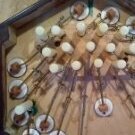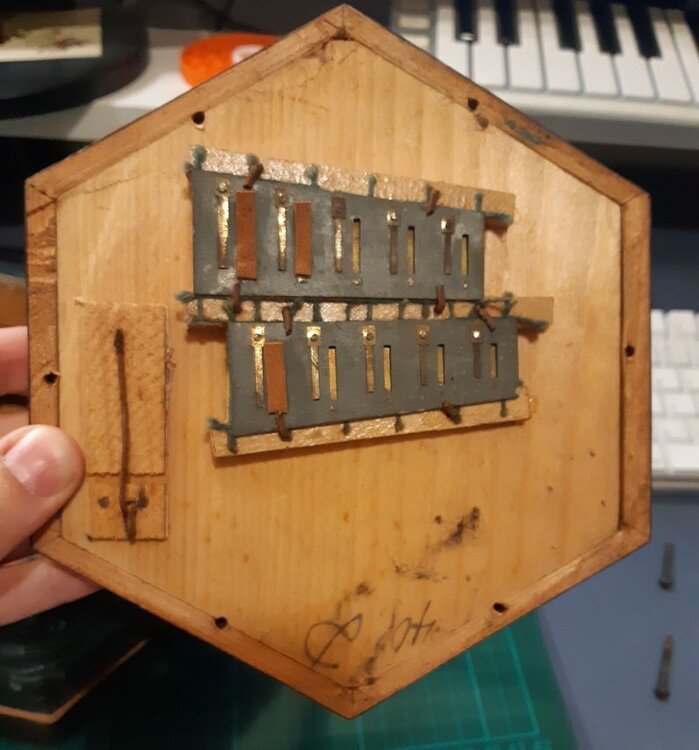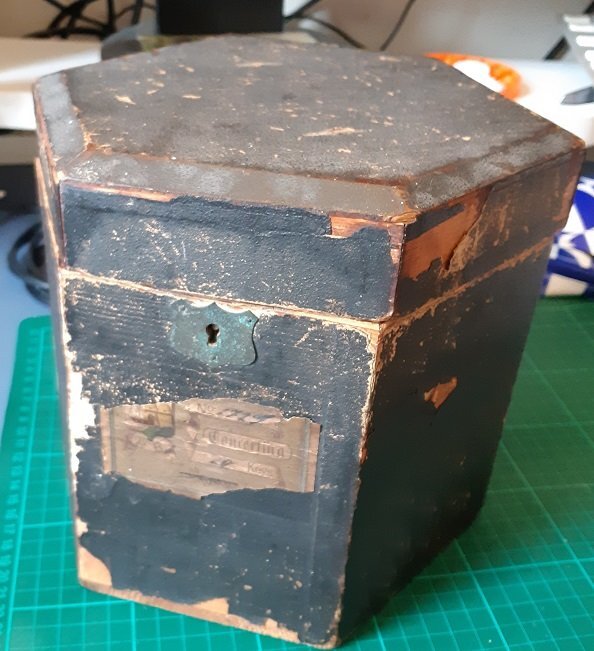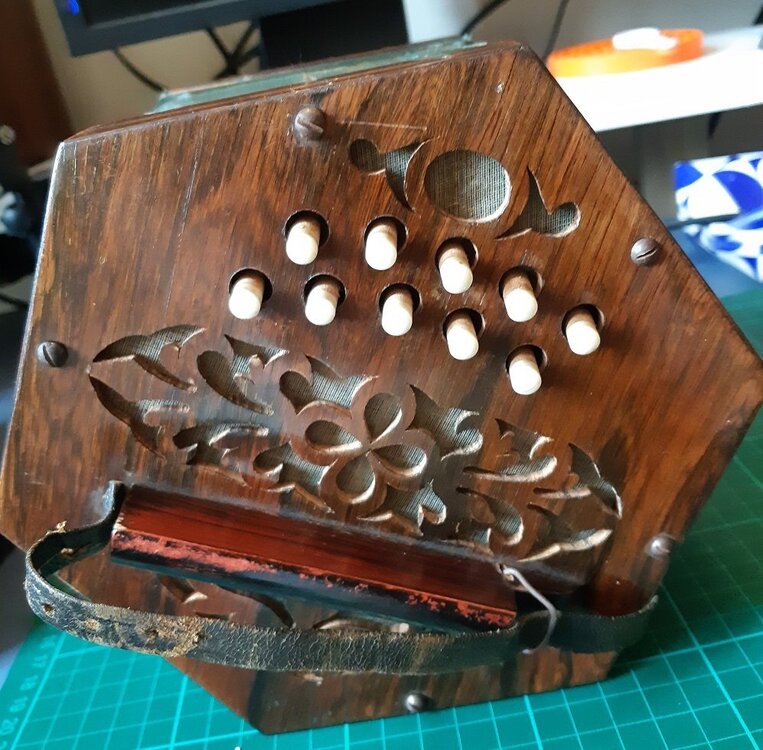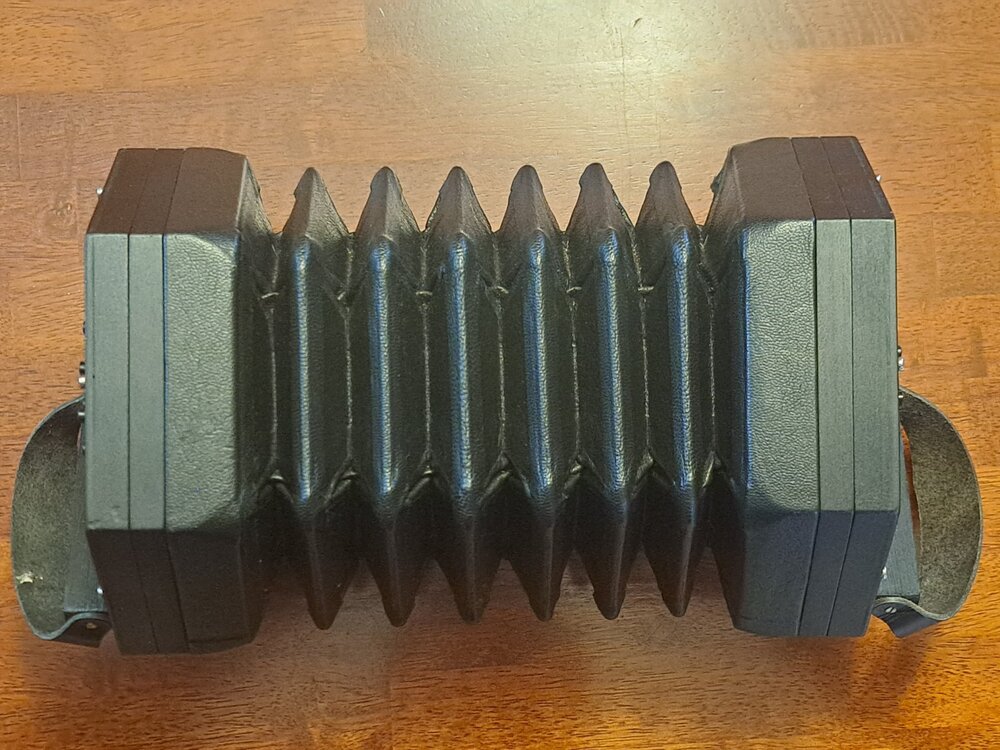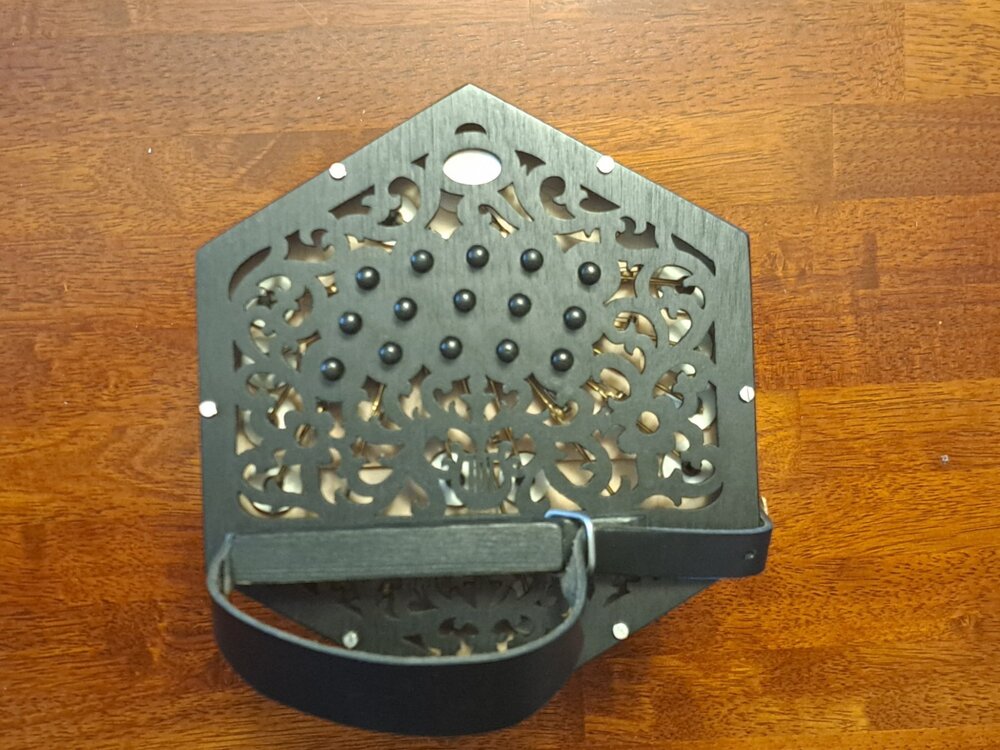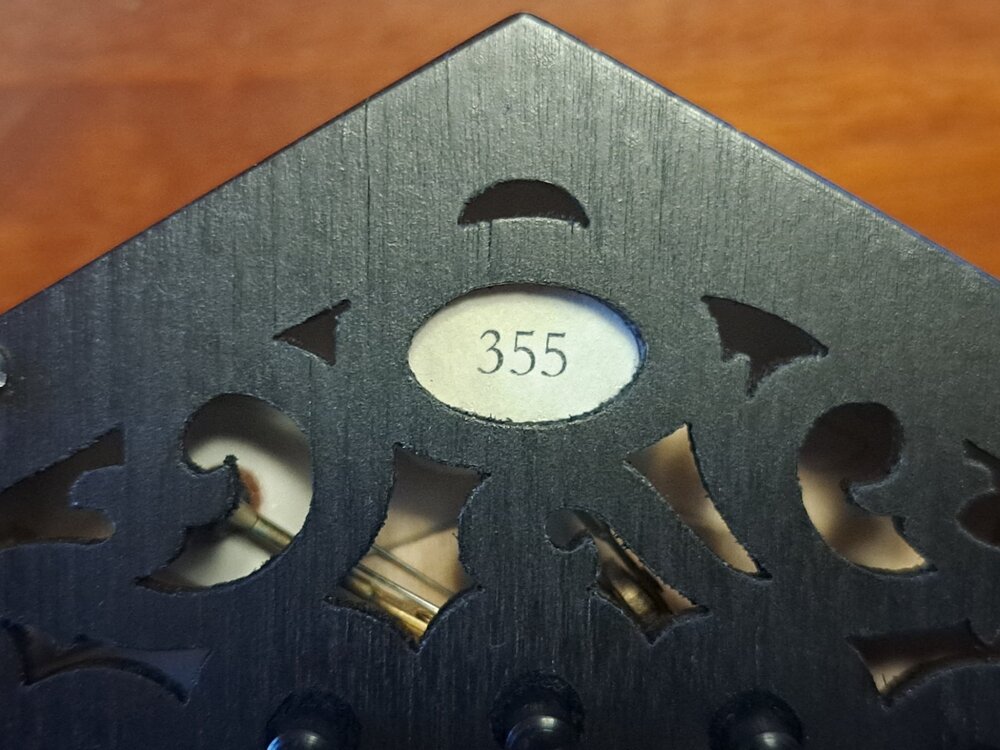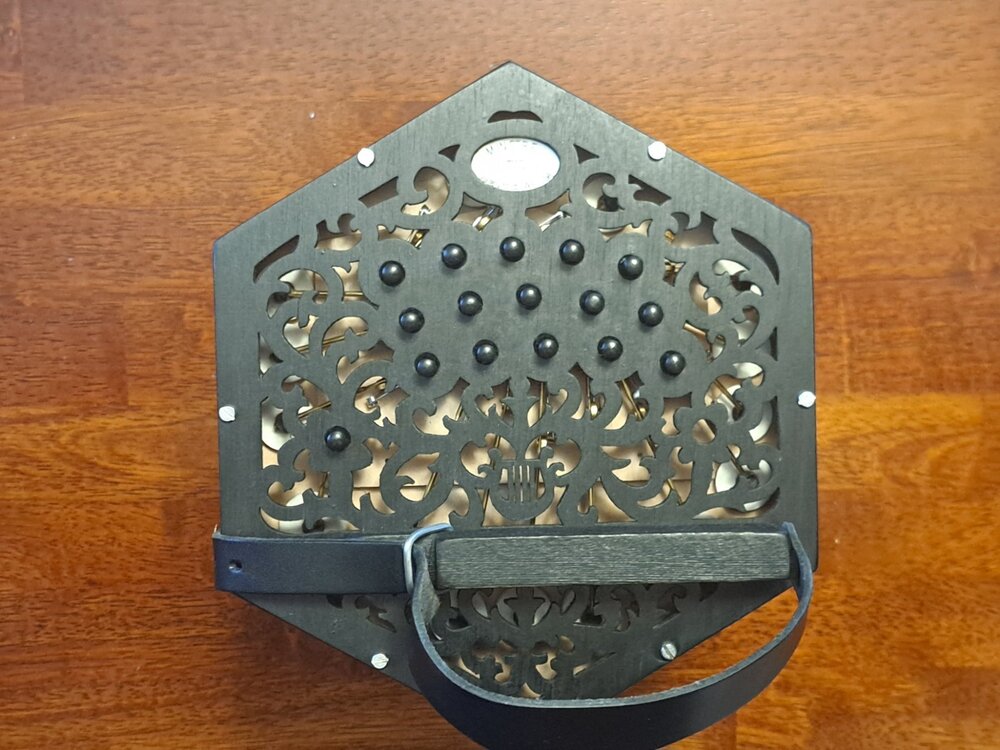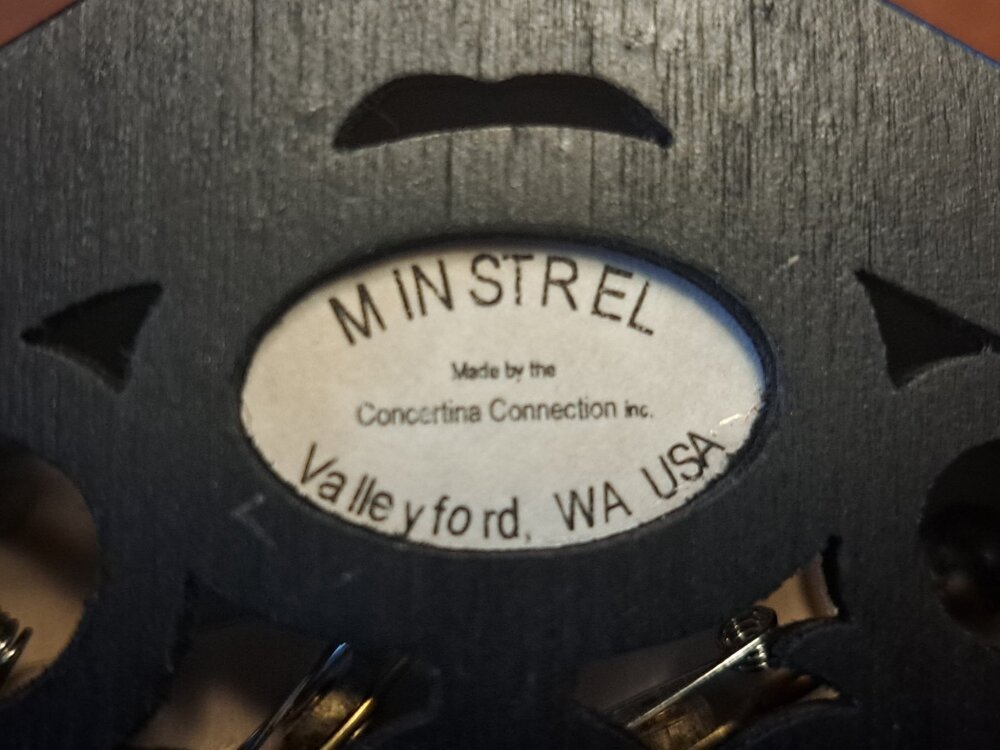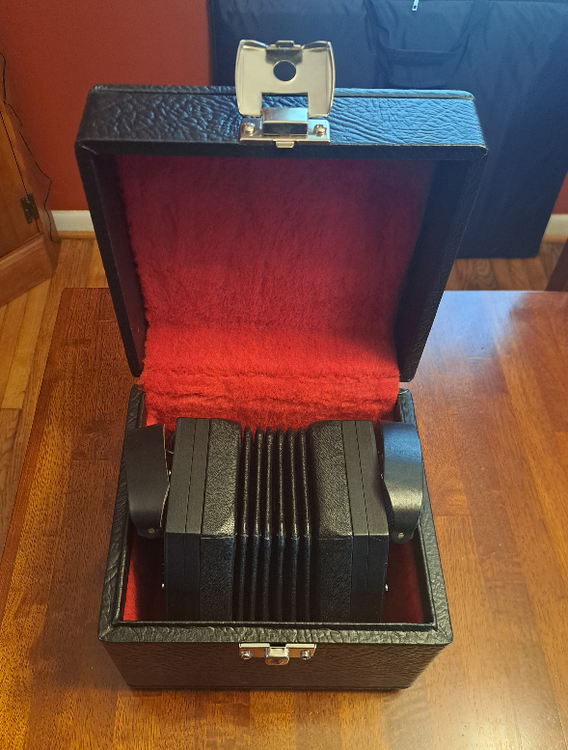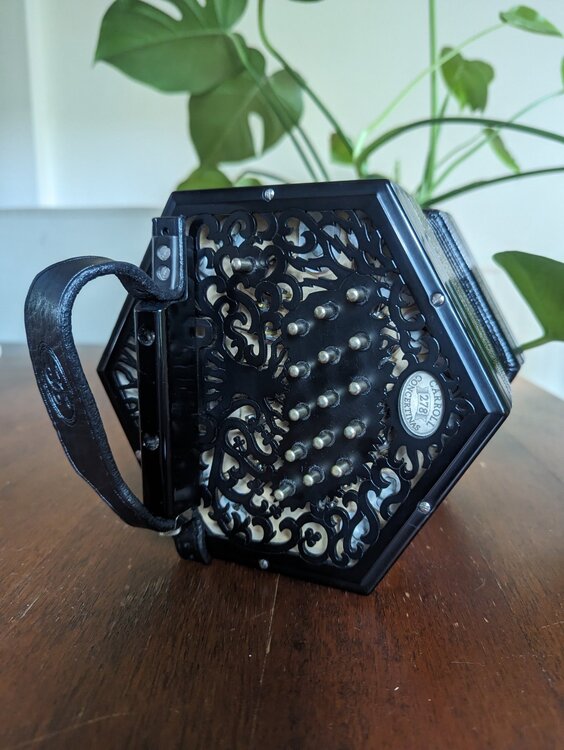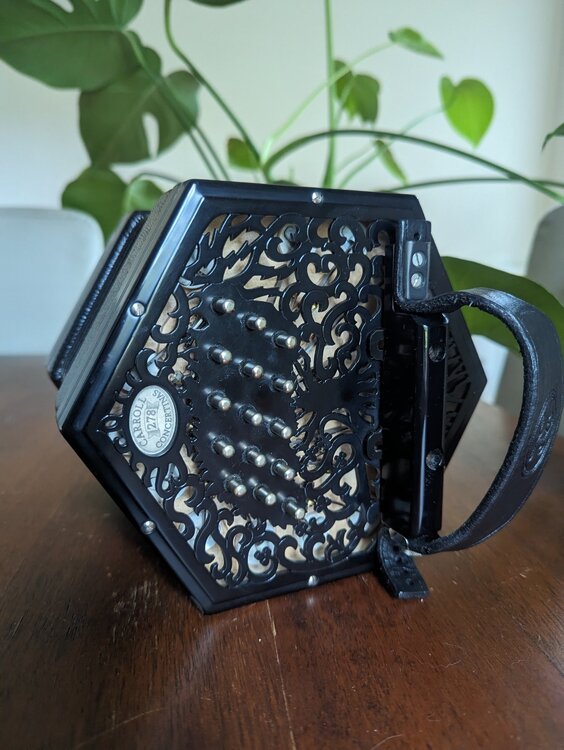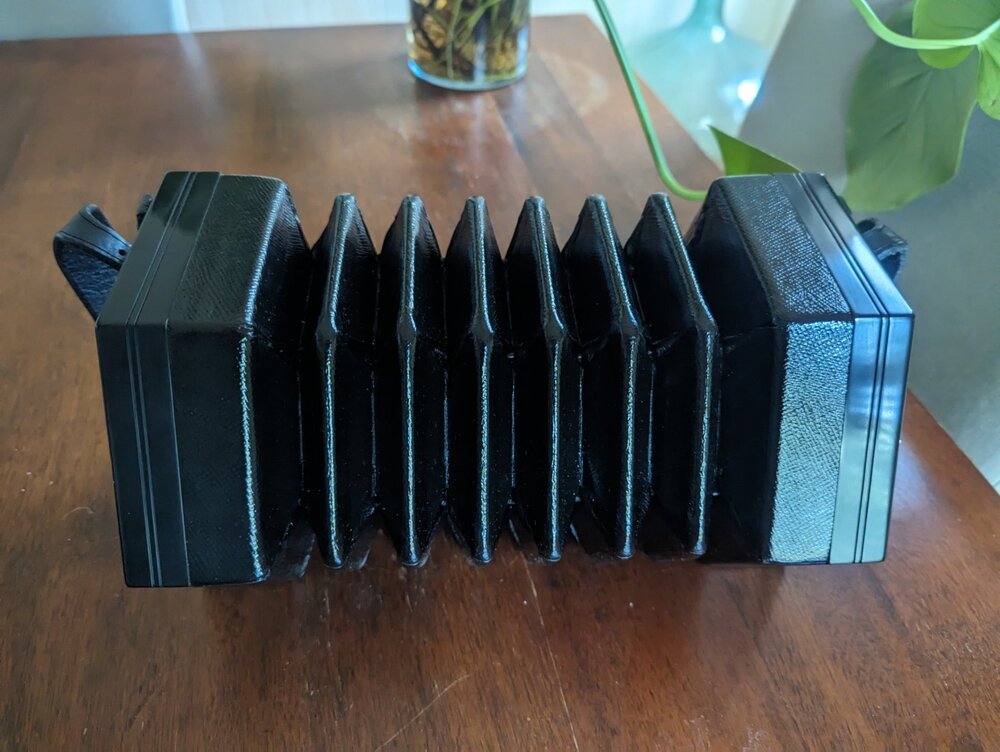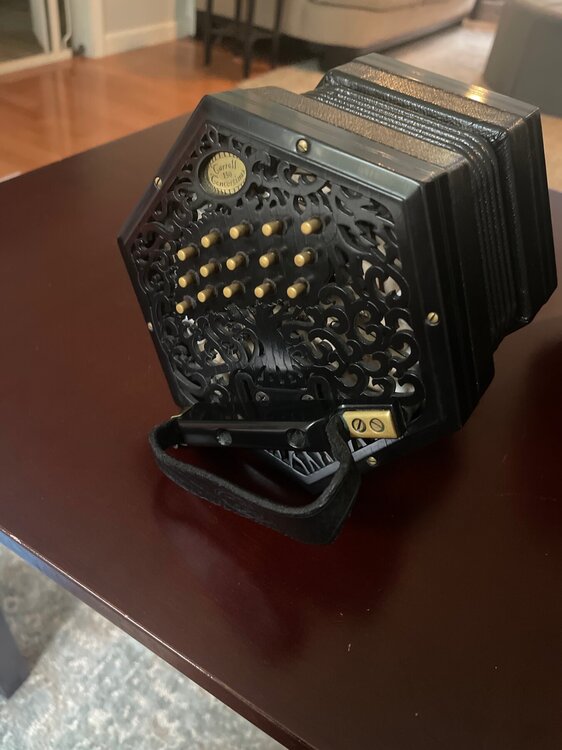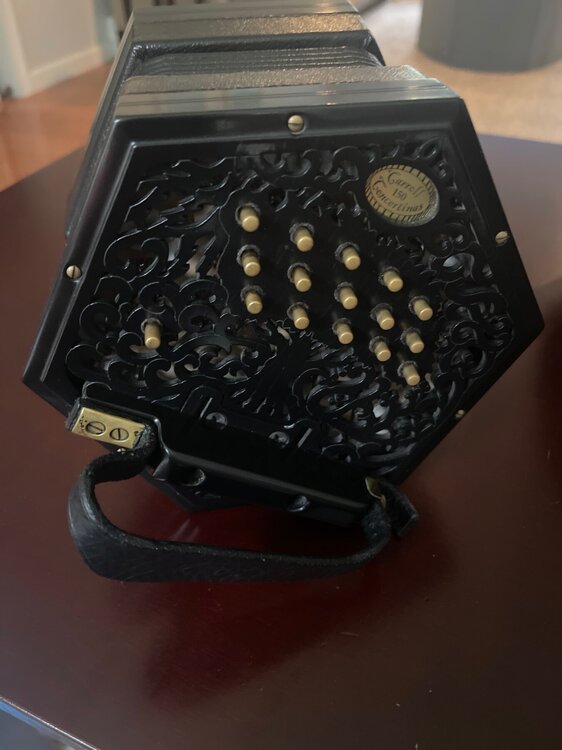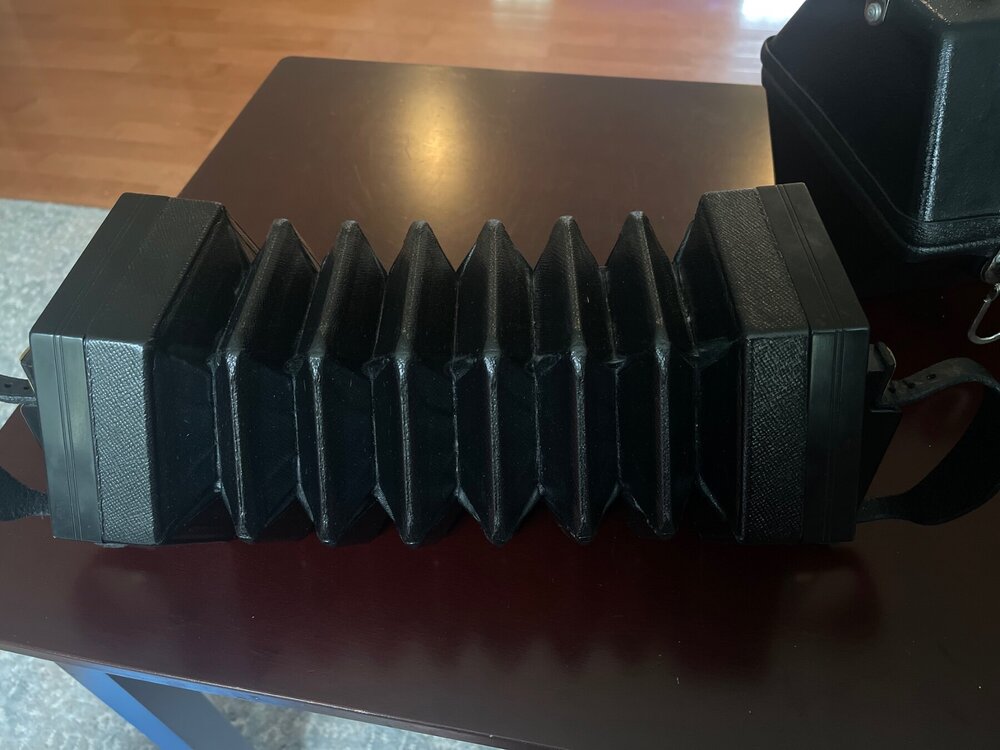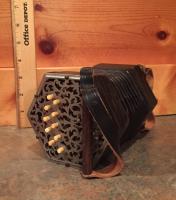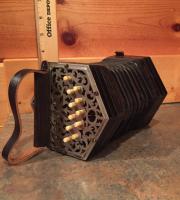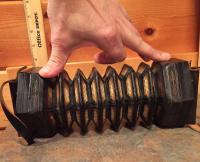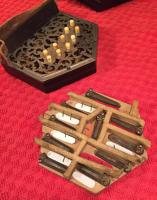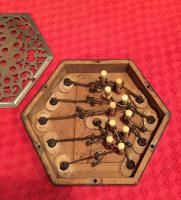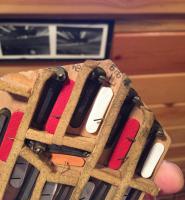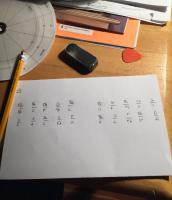Search the Community
Showing results for tags 'anglo'.
-
2 Edgley hybrids for sale, recently tuned by Karel van der Leeuw, and in quite good condition, keys C/G and G/D. PS the C/G has a 3mm leather support gasket adaption under the end-plates to decrease the too long sticking out buttons for ease of playing. Seems even the sound is better now, as i sold my Heritage in favor of this speedy player. The G/D has been converted from Wheatstone to Jeffries system professionally, with the same type Voci a mano reeds. Both include a case, 2150 euros each, incl concertina.net provision, and EU imports were paid for. Shipping DHL preferred, costs vary due location. Selling due my recent hearing problems. C/G: G/D:
- 13 replies
-
- edgley concertina
- anglo
-
(and 2 more)
Tagged with:
-
Seeing some discussion in other threads about large duets and the ability to reach the outermost buttons got me to wondering about the variations in Anglos since there are no standard dimensions among different makers. Some instruments are better suited than others for larger or smaller hands, and I know I have trouble with many Wheatstones feeling scrunched up, and I've also found the Minstrel to be absolutely unplayable. So, here is the reach for four different C/G Anglos. Measuring from the face of the handrest to the center of the top middle button (the "apex", or button 3A): Wheatstone #56716 - 70mm (2.75") Herrington (hexagonal, August 2000) - 74mm (2.9") Marcus #101 - 75mm (2.95") Wolverton #22 - 78mm (3.1") With the distance between the rows being about 10-11mm, these variations in reach are almost the equivalent of playing on a different row when switching between instruments! No wonder I have problems with Wheatstones, even with 1" handrests. What about other standard instruments from other makers? Gary
-
By special request, here are the dots to a lament, "The Last Cup", recently posted on YouTube. A reaction to the sad news of the upcoming loss of a local gathering place and coffeeshop, destined to be turned into yet another awful generic fast-food joint. Civilization going backwards yet again! Gary Last-Cup-GRC-ANGLO-Dm.pdf
-
Just for fun, and available through www.zazzle.com (search "Rollstonpress"), here are some concertina t-shirts for Wheatstone, Lachenal, and even one for Maccannics that even includes The Professor's visage and signature. While The Wife prefers name-brand stuff with logos, I'd much rather have something I'm interested in that's totally obscure and that no one has any idea what it is. And, if anyone would like to be a human billboard, there's also a Rollston Press shirt with a sampling of some of the book covers. The shirts are high quality print-on-demand, you decide what size and color, and Zazzle often puts things on 20-30% discount. Thanks to Steve Dickinson for permission to include the graphic from an old Wheatstone pricelist. And as they should, a portion of the proceeds will go to CNET. Gary
- 10 replies
-
- 1
-

-
- wheatstone
- lachenal
-
(and 3 more)
Tagged with:
-
untilTim Collins and Francis Cunningham, two of Ireland’s leading concertina players will be teaching and performing at Cascadia Irish Music Week this summer in Olympia, Washington. Cascadia offers five days and six nights of classes with some of the world's finest Irish traditional musicians, evening concerts and sessions, intimate talks and more. All this takes place in a beautiful, wooded setting next to Puget Sound. Dates are July 28 - August 3. Scholarships and financial assistance awards are available, see our website for details: www.cascadiairish.org Fiddle - Randal Bays, Eimear Coughlan, Therese McInerney Flute - Eamonn Cotter, Patsy Hanly Concertina - Tim Collins, Francis Cunningham Uilleann pipes - Mickey Dunne Button accordion - Josephine Marsh Piano and Tinwhistle - Geraldine Cotter Tenor banjo - Brian McGrath Guitar - Frank Kilkelly
-
- washington
- oregon
-
(and 5 more)
Tagged with:
-
For a number of years now a friend on mine has been building an experimental electronic Anglo concertina. He has now arrived at a reasonable working prototype. One of the features of this concertina is volume modulation using a twin port differential pressure sensor. One port of the sensor is connected to the bellows enclosure and the other the outside world. The actual differential pressure variation measured in the bellows during playing proves to be quite small, that is, less than 3 kilo pascals. Finding affordable sensors with that low pressure range has proved difficult. However, using a Chinese manufactured CFSensor XGZP190 3kPa is currently under investigation. The has led me to think about other ways to measure this activity that do not involve pressure sensors. Fundamentally, the energy expended by the player in moving the bellows end plates is transferred to the reeds and converted into sound. The force being exerted on each end plate can be measured using a load cell sensor of some sort placed where the heel of the hand meets the end plate. This force will be divided equally between all the currently pressed buttons. If the additional force applied by fingertips holding buttons down can be ignored, then a simple calculation to provide a numeric value that is applied to all the “voices” currently playing can be made. if the hand grips were hinged at the top with limited movement at the bottom then push and pull could be differentiated as well as measured. Otherwise a differential pressure sensor may still be needed purely to detect pushing or pulling. My friend says that this may have to wait for a future version! Apologies if this has been tried before. But any comments will be appreciated.
- 45 replies
-
- anglo
- electronic
-
(and 2 more)
Tagged with:
-
Cohen BK made the arrangement and we worked on it together in a lesson. I'm pretty happy with this take though I might try to work it up a bit more. played on a 30 key cg clover Tartini Andante.m4a
-
I have been reading (and listening) with great pleasure to Dan Worrall's book House Dance. I highly recommend it, both as a wonderful window into concertina history and an education in how to play the Anglo like the real old timers. I am a newbie on the concertina; I don't think I'd even qualify as a toddler, yet. But as someone who has played harmonica for years, and who acquired a melodeon shortly before acquiring an anglo concertina, I began my concertina playing without much in the way of instruction. Since I already understood the structure of the scale and how the buttons worked, I just dove in, transferring some of my harmonica repertoire over to the squeezebox. Rather quickly, and instinctively, I started playing some tunes in octaves -- at first along the row, and then discovering that I could move down to the G row in order to gain notes above A on the left hand. The same trick work on the right hand, too! Eventually, messing around on the web, I found that this octave style was indeed one of the ways folks traditionally approached the instrument, and I discovered Worrall's House Dance, which focuses on just that style of play. Octave playing was once the most common approach to the anglo (or German concertina), used to gain volume and reinforce the beat when a single unamplified concertina might be the only source of music for thirty couples dancing across the dirt floor of a settler's home in South Africa -- or across a wooden platform laid down at some Irish crossroads. I mentioned "listening" to House Dance. The "book" is delivered on CD as a set of well-illustrated web pages and associated audio files. So, as you read about the differences in the octave playing of Scan Tester and William Kimber, you can actually listen to recordings that illustrate the point. The first six chapters of House Dance provide a historical exploration of the concertina's place providing music for dance in the late 1800s and early 1900s in England, Ireland, Australia, and South Africa. The second six chapters look in depth at the playing of traditional concertina artists from each of these countries -- and provide a tutorial in the octave style. The huge number of recordings that accompany the text are a wonderful resource. And these are not recordings that you're going to find on Spotify. (I know; I've looked!) They are from private collections, museums, and other hard to find sources. In addition to music, there are also recordings of interviews with old-time players, talking about the octave style and the house dance context in which it was used. The whole thing is just a flat out marvelous piece of work -- and not just for the historian. There's plenty to learn about playing the anglo in the "pages" of House Dance. I've gone on enough. I ordered my copy of the CD from the Button Box. But there are other places to get it. Worrall's website will point you to the options. All the profits from sale of the book go to the English Folk Dance and Song Society. It's just an excellent piece of work. Dan deserves plenty of thanks for creating it. Happy Squeezing! Greg
- 5 replies
-
- Octave style
- dance
-
(and 2 more)
Tagged with:
-
This is my 2¢ about a lesser-known maker I had the good fortune to meet last year ~ I just received a new C/G anglo from Crook Concertinas. I waited a mere 3 months to get it. Details and description below - And here is the contact information for the maker: Crook Concertinas Williespoke@gmail.com 303-960-3701 https://www.instagram.com/crook_concertinas/ https://www.youtube.com/@CrookConcertinas/ Willie Crook says the best ways to contact him are email and direct message on Instagram. This thing is hard to put down. The tuning is impeccable and the reeds respond so quickly that I'm still adapting to it, feeling like I'm learning how to drive a modern car after coasting to work in an old Datsun. His workmanship is detail-oriented to an uncommon degree - he even puts effort into the beauty and polish of the normally-hidden internal mechanism just in case someone opens it up to have a look. I toured his Colorado shop in November. A machinist with his talent and experience could be making governors for Woodward or injectors for Boeing or whomever. Instead, Willie Crook is building little button boxes for the likes of us. And they perform QUITE nicely. He makes three sizes - 5⅝", 6¼", and a baritone. He pours a lot of time and energy into his handmade concertina reeds. (See his youtube channel.) He has various options for woods, buttons, and bellows papers. Endplates can be wood or metal, and the particular pattern I chose is unique to Willie's concertinas. ¯\_(ツ)_/¯ So how did I end up with one of these? This fall I realized I wanted another concertina, and I spent time reaching out to every maker for whom I could get contact information. After several attempts, many (including a few well-known names) have remained unreachable. But I took detailed notes when someone responded, and collected data on about 30 makers. In the end I learned some interesting things, and talked with a lot of players about whatever they had in the case. There are lots of good-looking possibilities out there, but of course many have raised prices dramatically, and many have a waiting list which is several years long. We're used to this, I suppose. But I made a project out of talking to everyone because I wanted something good. People had only positive things to say about Willie's concertinas. He operates in Denver and he is an easy maker to reach. When my instrument was finished we had a session in his kitchen, sipping tea and trying out old tunes on the new machine. This maker plays concertina and plays it well, and he maintains a high standard for the shiny contraptions leaving his shop. We live with the fact that looking for a good concertina is a bit harder than shopping for a violin or a guitar. I think Crook Concertinas is a great option for someone who wants a meticulously-made, high-performance instrument, doesn't want to pay over the top of the current price spectrum to get something from one of the big concertina dynasties, and doesn't want to wait until the end of the Holocene extinction for it.
- 25 replies
-
- 3
-

-
- crook concertinas
- makers
-
(and 3 more)
Tagged with:
-
I've just tried my first YouTube Short video (it's only a minute long) This is an improvisation on the introduction to On from Abberley, that I just posted. It didn't fit in with the video, and works on it's own.
-
Playing and dancing! Does anyone have any experience? I never set out to do it consciously, but whilst we were playing for a dance, recently, I ended up dancing at the same time. It's only a single step, but it's a start! It felt very natural indeed. I've seen some musicians dancing Cotswold jigs whilst playing a fiddle or melodeon and that looks pretty full-on! I'd love get a feel for Cotswold stepping and how that "feels" to play and move to, but there are no sides closer than 50 minutes away that I could dance with. We are definitely in the middle of deep deep Border country Holly is behind me, here, on fiddle. We were moving around, engaging with the audience and generally having a fun time. The concertina is well suited to dancing, I think, because it's relatively small and light. I need to think a bit more about what works and doesn't, musically, when dancing (and when playing standing up), but it's encouraging. This is at Compton Verney, the impressive 18th century building/art gallery a good hour or so east, in Warwickshire - Bow Brook Border Morris were dancing there as part of an early Wassail evening. Unusual for us to dance inside for a Wassail! (Some musicians were escorting the public around the trees outside too) It was quite a full-on performance, as we were the only side dancing and in between dances the musicians and those of us dancers who were also musicians, took a turn to play tunes. I did get to sing a couple of mid-wintery songs too. Revving up for Wassail season coming soon!
- 16 replies
-
- 2
-

-
Sorry, I am new, and this is my first time advertising here. I have a very rare (I hope!) and beautiful concertina for sale, and I was told this was the place I needed to advertise it... So, if I am making a mistake I am not aware of, like advertising in the wrong place, kindly let me know. Thank you! SUPER RARE VINTAGE 40 KEY L. LACHENAL AND CO ANGLO CONCERTINA IN WHEATSTONE LAYOUT IN AMAZING SHAPE! $3995.00 This is a part of history, and I hope it would find its way to a museum someday, where it would be preserved in this condition, and displayed for generations to see. It is by far the most interesting, and the rarest musical instrument I've ever laid hands on! It's a very cool, and beautiful piece of the past, in pristine condition (for its age!); and it is estimated to be over 110 years old! First; I want to disclose that I know absolutely NOTHING about concertinas, and all the information shared in here is gathered from hours of research online and talking to experts around the country. So, I cannot guarantee the accuracy of any of the information gathered in this ad. Finding the information about this beauty has proved to be the most difficult gathering of information for me, as there is very little information available (mainly because of the age, and how rare it is). And being that I am not an expert at all, I cannot tell if what I have found was fact or not. So, please forgive me, and ONLY rely on your own research and the many pictures I have provided. Also, feel free to ask for more pictures! 🙂 Even though I know nothing about this wonderful instrument, I still want this ad to be as accurate as possible, and do not wish to mislead anyone. That is why I have spent 10s of hours gathering all that I could... I took it in as a straight across trade on an expensive synth, because I fell in love with it. So, I rolled the dice... 🙂 According to my research, it was built in London, back in the late 19th - early 20th century, by a company who a Swiss (watch maker) immigrant started, after immigrating to England. This is an Anglo concertina in Wheatstone (ish!) layout, and was made by L. Lachenal and Co. It is a 40-key (very rare!), and it's presumed to have been built/sold sometime around or before 1913. I have spent a lot of time online, and with the instrument, and have mapped out the note of each key (in and out) on both sides, using a tuning app (please see it in the pictures). It appears to be a GD, with a drone key of A3 (in and out). I have also recorded a video (very poorly played...please accept my apologies!), which I will upload to YouTube, and will make available in here. Inside you can see the quality of the reeds from its bellow entrances, and they are still in great condition (for its age); which means it had been kept away from dust and dirt all its life. The wood surrounding the bellows has achieved a peak resonance over the many years, and makes a heavenly sound, that only a 100-year-old violin could match. This amazing wonder plays beautifully, and has a massive sound that fills the entire home; despite being old, and not at all big!?? All parts and pieces are believed to be original (not a guarantee!), and not replaced. It seems to have been built/repaired/serviced (?), back in 1913 (according to the writing inside, which seems to be authentic). Please keep in mind that you may need to have it serviced by a professional, prior to making beautiful (and accurate?) music with this lovely instrument. This gorgeous piece of art still functions wonderfully, as it did over 100 years ago, when it sang the songs of the exotic from faraway lands, across the Atlantic, across the Continental US, and through other passages unknown... Who knows what mysteries it holds, and what adventures it has been a part of... (The above information is gathered from many sources, including the web, so I cannot guarantee the accuracy of the statements, but believe them to be accurate, to the best of my very limited knowledge on this instrument. But one thing is for sure, this is an amazing and enchanting piece of history...) THIS WOULD MAKE AN AMAZING GIFT FOR ALL OCCASIONS, INCLUDING CHRISTMAS, BIRTHDAY, ANNIVERSARY... 😉 Please feel free to ask me any questions; I will try my best to find the answers for you. Thank you for reading, and have a wonderful day. Cheers, Kevin P.s. I PACK SAFE and SHIP FAST! A VIDEO: https://www.youtube.com/watch?v=l1o-n9Wnw5U SUPER RARE VINTAGE 40 KEY L. LACHENAL AND CO ANGLO CONCERTINA MADE IN LONDON UK IN AMAZING SHAPE! www.youtube.com A LITTLE ABOUT ME: I am a 46-year-old, with a degree in electronic engineering, who LOVES Synthesizers, Music, and Electronics in general. Even though I do not work in the electronic field; I have always loved it, never separated; and as a hobby, I collect and fix them (if broken); and sometimes sell them to make room for others... And, to make sure the next owner would not have any issues, I test them, open them(if necessary), and serviced them. YOU CAN SEE THE PICTURES, AND PURCHASE, ON REVERB: https://rvrb.io/l-lachenal-and-co-1wdoe8 FOR INTERNATIONAL SHIPPING, PLEASE MESSAGE ME!
-
Recently began to work through Gary Coover's excellent starter book for left-hand (LH) harmonic accompaniment on Anglo concertina. Many of the melodies presented in his book are English Country dance tunes, Morris tunes, and original compositions. They can be transcribed into C, Am, F, and Dm which have many LH chord patterns for the 3 or 4 chords required for many tunes. Some more limited chording can also accompany G and even D tunes. The practical requirement is that "most" of the tune be playable on the right hand. Many Irish tunes sit in the middle range of the fiddle, whistle, flute and pipes; low parts of melodies will commonly fall below G or A above middle C and are played with the LH on the Anglo. So, even though it's not traditional, I'd like to see, or work on collecting, a list of Irish tunes of any genre that either fall within the right hand, or can be transcribed into a key that fits there. A subset is tunes that have a second, high or B part that is right hand only. My starter tune: Kesh jig. Except for the tonic G and the A that follows, the tune is all right hand, and notes can be found in the LH for the 3 required chords.
- 11 replies
-
- irish
- harmonicstyle
-
(and 2 more)
Tagged with:
-
"Joy to the Person of my Love" is a baroque era, courtly Scots song with lovely 6-chord minor to major harmonies. It is also played very slowly. As such it makes a good exercise for harmonic Anglo on the Left Hand following tab conventions of G Coover. I've left it to the player to work out the right hand melody, with just a couple of footnoted suggestions. I'm new at this, finding the voicings and getting my fingers to the more distant buttons, so comments and suggestions welcome. Joy to the Person of My Love_Am.docx
-
Thanks to help from people in this forum, I was able to locate and make contact with the owner of Concertine Italia. Last Thursday, I visited the factory and spent a couple of hours talking with the two women who make pretty much every part of their instruments, with the exception of the reeds and reed blocks. A lot of people helped me along the way. I'm especially thankful to my new friend Enrico, who thought a visit to a concertina factory would be a good adventure and offered to drive me there, and to serve as translator. I can speak a little Italian but quickly got lost in the specifics. The owner, Mrs. Simona, is an awesome person as is her only full time employee Rosalia. Together they make a range of instruments including an adorable tiny 18 button chromatic, and the Italian organetto. They say that their most popular model is the Hayden. I am so grateful to have had this opportunity. I think you will like these awesome makers as much as I do. You can find the video at
-
I got this old German-made 5 fold impulsively and cheaply as my entry into concertinas. I want to have a go getting this more playable, changing as little as possible and preserving what I can. I have time, skills and tools but seem to be low on money as always. So far I gather it was made sometime between 1850 and 1940 which isn't greatly precise but enough for me to consider this as something from "the olden days". I don't want to unwittingly ruin anything historical and I plan to keep anything I remove or change because at the very least its interesting. And also write a note about what I do to leave in the case. It is what I would consider playable. Notes seem to be relatively in tune and most all working. Some notes don't sound as easily as others unless the air is pushed harder, I could describe as maybe a bit wheezy and breathy? I've been able to play some basic little tunes (and had a lot of fun so far ) and I'm planning to carefully clean the reeds with something akin to a Q-tip and isopropyl. The bellows seem okay but if you hold one end up and let the other drop without holding any buttons, It will slowly expand over about 16s. I plan to shine a bright light through from the inside of the bellows and patch any holes with a suitable glue and paper or very thin leather. Any recommended glues and kind of paper? (Is PVA wood glue okay?) - Some notes buzz in an old-timey alarm fashion, I figure the pin holding the reed to the plate is loose, do you think this is a nail/ screw/ rivet? - Does each reed need a leather flap? (brown reed flaps as pictured below) Is this potentially the cause of the harder to sound notes that are wheezy? I want to fix the box with new hinges and latches. I don't think I can get the lock working despite having an old key that I ground the tooth on so it fits well and turns but hits a dead end both ways at about 140 degrees. I think I'm best to add some new low profile latches on the outside. I will try make any new brass look old, I love the old look of the case. As I've been told in my previous post, I will store this on its side. I'm thinking some kind of matt Mod Podge or varnish to seal the outside of the case and protect the cool old label. Also may add some old wood splines to some of the loose corner joins. I think it would be cool to keep the splines visible, is this a crime? For the handles, will find some old aged leather that looks the part. I think the thumb button may need fixing too under the bone cap. I can figure these things out! Overall, I don't mind if its a little out of tune and scratchy, as long as its just playable enough. I think the roughness and patchy repairs is charming and suitable for this instrument. Maybe one day I can get (or make...) a better one Any advice is greatly appreciated, and thanks for taking the time to check out this post Even just pointing out any red flag in my approach would help! Happy to take more pics and do progress updates if people are interested. ❤️
-
- repair
- restoration
- (and 4 more)
-
This is such an unusual and gorgeous sounding traditional tune, with a fascinating history. Makes for a fun time exploring what can be done on the anglo with it! For once this isn’t a tune of my own, but I couldn’t resist adding plenty of new stuff inspired by it in there! If you watch to the end there’s a little dance tune based on it that’d do well on its own, too.
-
SOLD!! Specifications: Jeffries layout accordion reeds riveted brass action Delrin domed buttons bushed key holes and action Wakker bellows (high end traditional concertina bellows) Hardshell case with red felt liner.
- 1 reply
-
- 1
-

-
- concertina connection
- minstrel
- (and 4 more)
-
Carroll Concertina #278, C/G 30-button. lt is the standard size in all black with a celtic tree endplate design and adjustable handlebars. I am the original owner of this instrument, I had it built towards the end of 2019. No leaks, holes, scratches, or damage of any kind. Occasionally the endplate screws need re-tightening, but when I asked the repair folks at the Button Box they told me it was nothing to worry about and is fairly normal with new instruments. Good volume, bright tone, and fast action, if I played more I would keep her, but I don't and she's too lovely to sit around and collect dust! Asking $5800 $5500 (+shipping), comes with hard case.
-
Hay everyone, i just bought a Wren from McNeela Music and im hoping that it’ll fulfill my needs. I searched and skavenged the internet for some answers. Maybe you guys can help. I mostly want to back up my singing with the concertina. I come from Ukulele playing and the playing sheets I have are with guitar chords. I’d also like to play some soundtracks from Games and Movies. And I like the style of playing chords an melody at the same time it just sounds more complete to me. I tried to get a Duet at a reasonable price but couldn’t find one for shipping to Germany. Would you guys say if I learn from scratch I’ll be able to do want I want with an Anglo? Or should I try to get a duet for my purposes? thanks for y’all’s advice in advance!
-
Wally Carroll #150 is currently for sale. I recently acquired a Jeffries and can’t keep both. $5500 or best reasonable offer. This is crossposted but 2% will be given to cnet should it sell here. Absolutely no issues with it. Right hand accidental row has C#/C# and C#/D# I’m at least the third owner that I know of. Has the adjustable bars with the Celtic Tree end plate thanks for looking
-
Check this little 20 button beauty out. Not quite 4" flat to flat. She is right in between Eb/Bb and E/B, and beautifully in tune with herself, but not as airtight as I would like. Serial number 48556 by one source appears to have been made 1876 ish? Is this a rare specimen or pretty common? It has amazing sound for such a small thing...
-
This is a warm and wistful waltz for 20 button anglo. It came about after a walk into the sun through trees on farmland just west of Worcester. I'm not quite sure why it came out like this, but it all got just a teeny bit Sound of Music somehow! I shall probably whirl around in a meadow come the late spring! The first section of this tune uses the melody in the left hand, accompanied in the right. The middle section swaps roles. It feels good to play and just dances along.
-
repair Who's taken over from The Button Box?
Keshlam posted a topic in General Concertina Discussion
Many years ago, bought a fully reconditioned Anglo concertina from The Button Box. I've always been within day-trippable distance of the store since then, so I hadn't had much reason to shop elsewhere. Unfortunately they closed down in 2021. And I just had a spring fail. (With, of course, an informal performance scheduled for this weekend. Murphy was an optimist.) So who *are* the most reputable concertina repair shops these days? I'm currently in the Greater Boston area, but Im willing to consider traveling. And, while I'm asking: Should I take this as a warning that it's worth doing a full overhaul again? If E fails, C and G are presumably not too far behind, and the only maintenance in the past decade has been my occasionally recentering a reed or removing dust. Tnx in advance!- 21 replies
-
- concertina
- anglo
-
(and 1 more)
Tagged with:

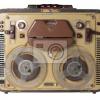












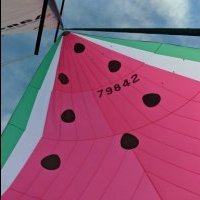

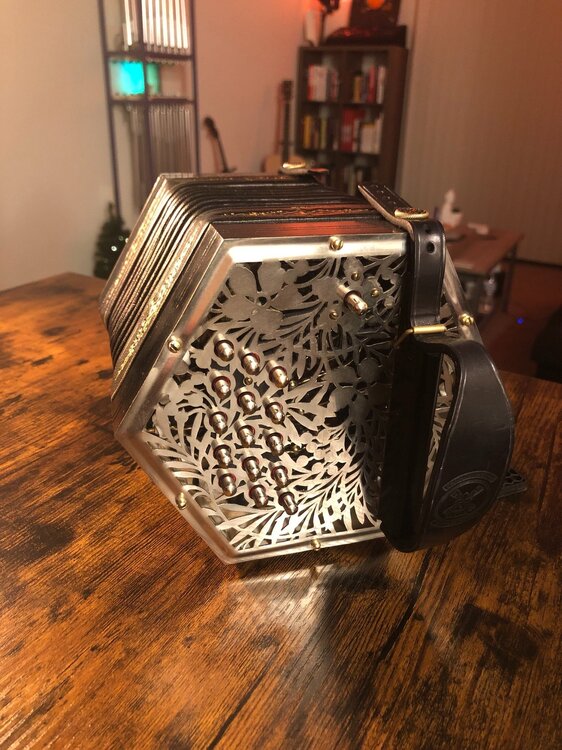
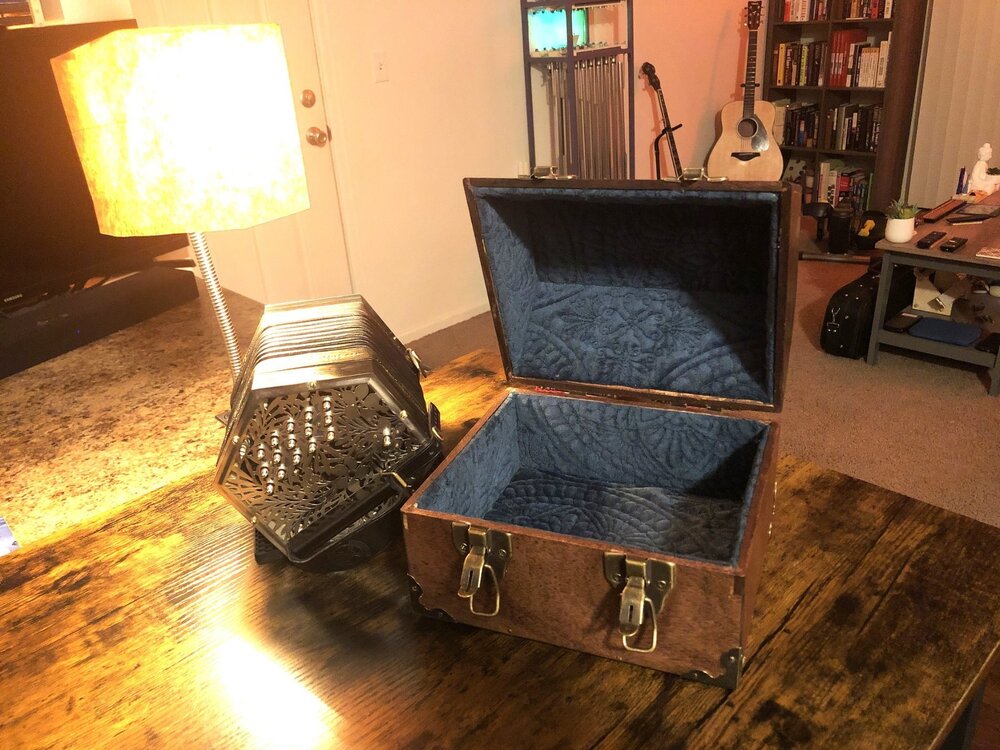
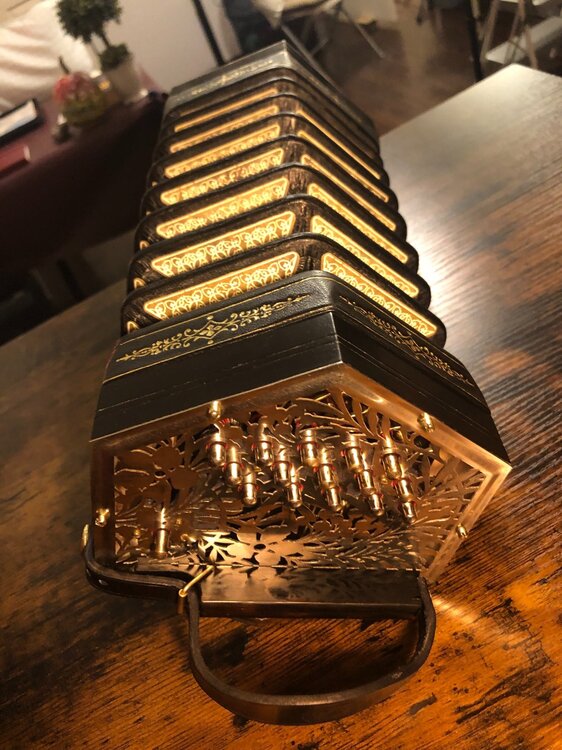
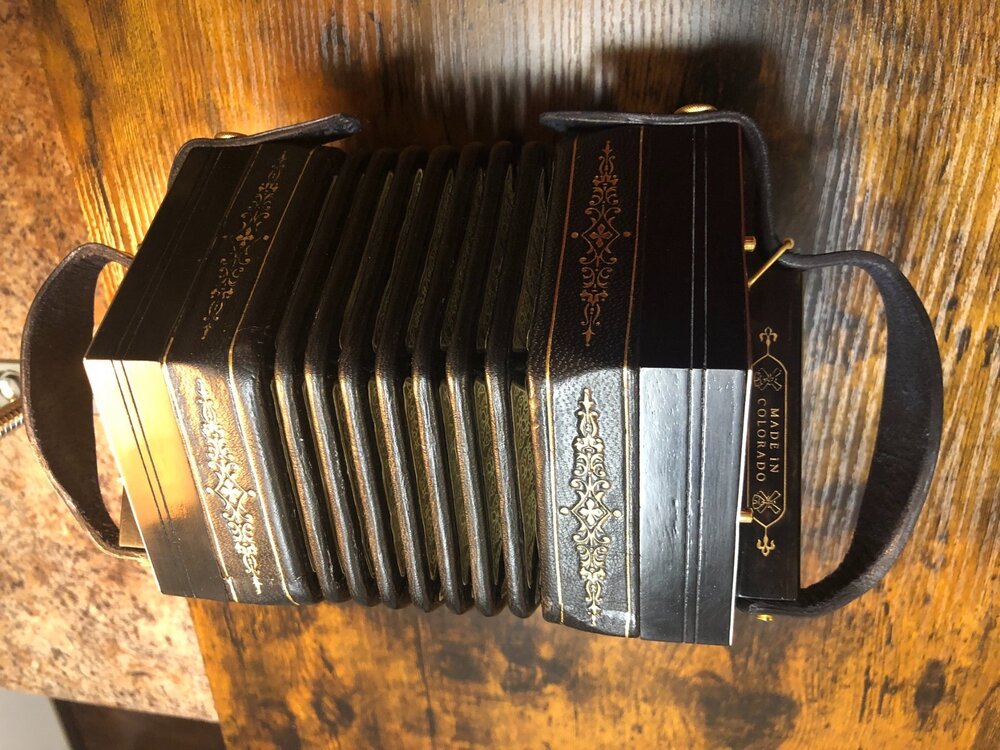

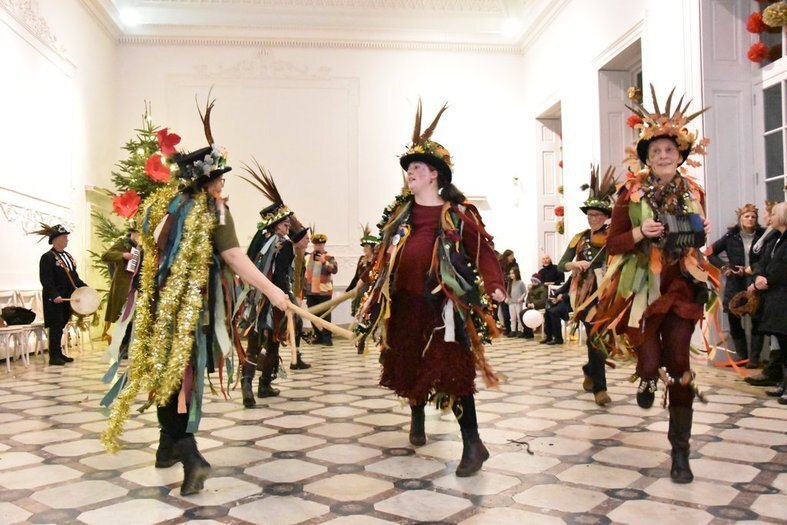
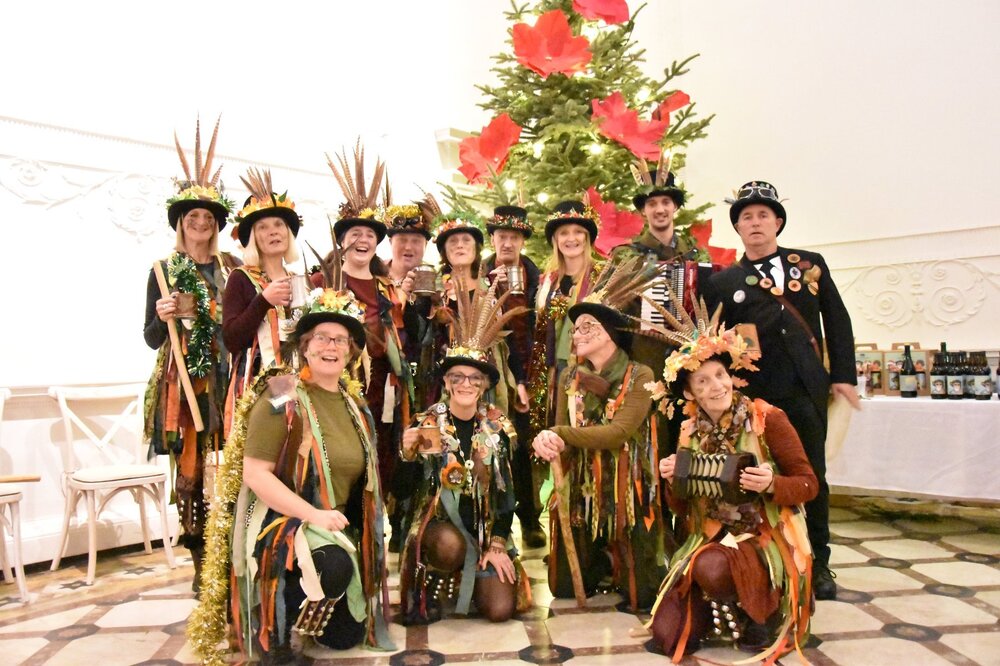
.thumb.jpg.1748056359dedb6c3090bcd392b3a5b2.jpg)
.thumb.jpg.24bfa09ce129bfb10165ce798f8321b5.jpg)
.thumb.jpg.e201997a236a0aced5cb8440135629bb.jpg)
.thumb.jpg.e720b71bee80784237148a978a108d74.jpg)
.thumb.jpg.24605f637edc1d686623b8c641f855a8.jpg)
.thumb.jpg.e9d850e4dbb12532330ae7d3c62158b8.jpg)
.thumb.jpg.dfc886a85bcf6ad6dda7b04c9faabd01.jpg)
.thumb.jpg.cfff071cda5c46a0384e052143917105.jpg)
.thumb.jpg.8b478ced376d712b86efcc420d75ba6a.jpg)
.thumb.jpg.44c3e6ff61bf290bf4192d5ccf7b87e3.jpg)
.thumb.jpg.13a5bf15795c62a538909d871a7146d7.jpg)
.thumb.jpg.83f27b6e93bf4e522bae6d35579f4942.jpg)
.thumb.jpg.32bacf66cd32ab49180dccfafb3a120d.jpg)
.thumb.jpg.c2308634adda5bd9606e30263de9bd3f.jpg)
.thumb.jpg.39a93eaa55476948ef954b177d790bfa.jpg)
.thumb.jpg.90a2d1bae862b13195a4cf7c1c97486e.jpg)
.thumb.jpg.07b41b6c5ddaf47fc1e5a3406f01cea8.jpg)
.thumb.jpg.0c3d8349729c2bc0f18a110246be49a9.jpg)
.thumb.jpg.693547f00ac9b61ebeb162bfd0b12451.jpg)
.thumb.jpg.3880ce2c033105f965beffc145c79530.jpg)
.thumb.jpg.3e438711e977fa6f206c4baf04203b1f.jpg)
.thumb.jpg.b705c45490865e248de0b05d4a5438c2.jpg)
.thumb.jpg.4fb3f164c46cb00272f184468524f371.jpg)
.thumb.jpg.2c632a885b07419613a99741be03c4ae.jpg)


